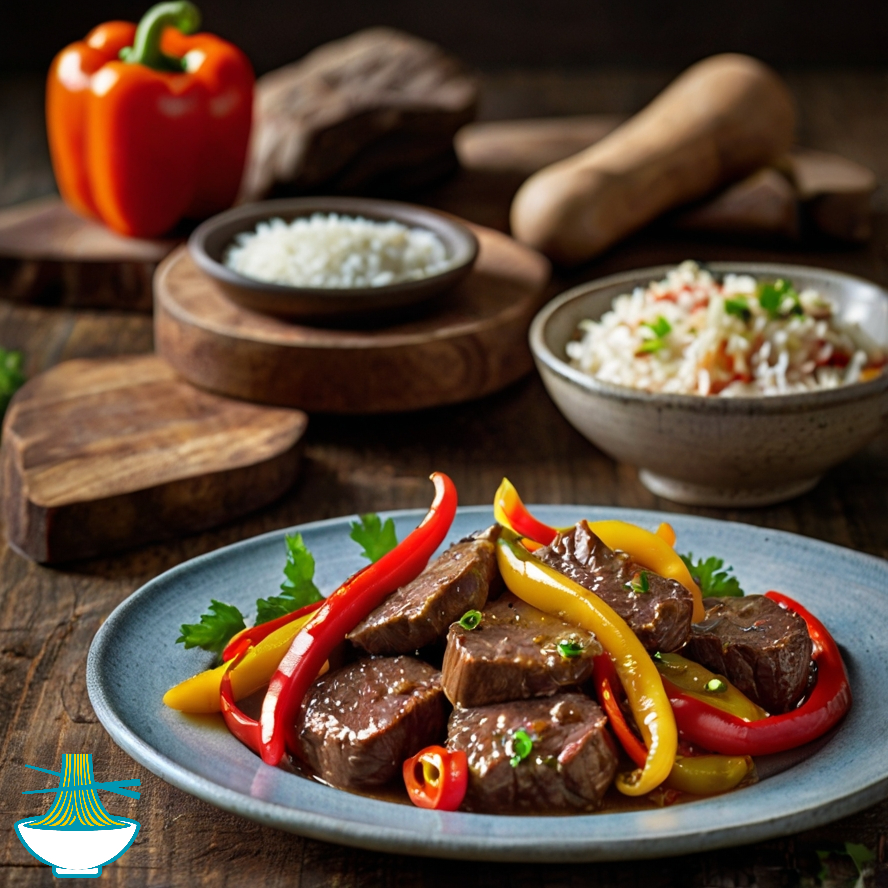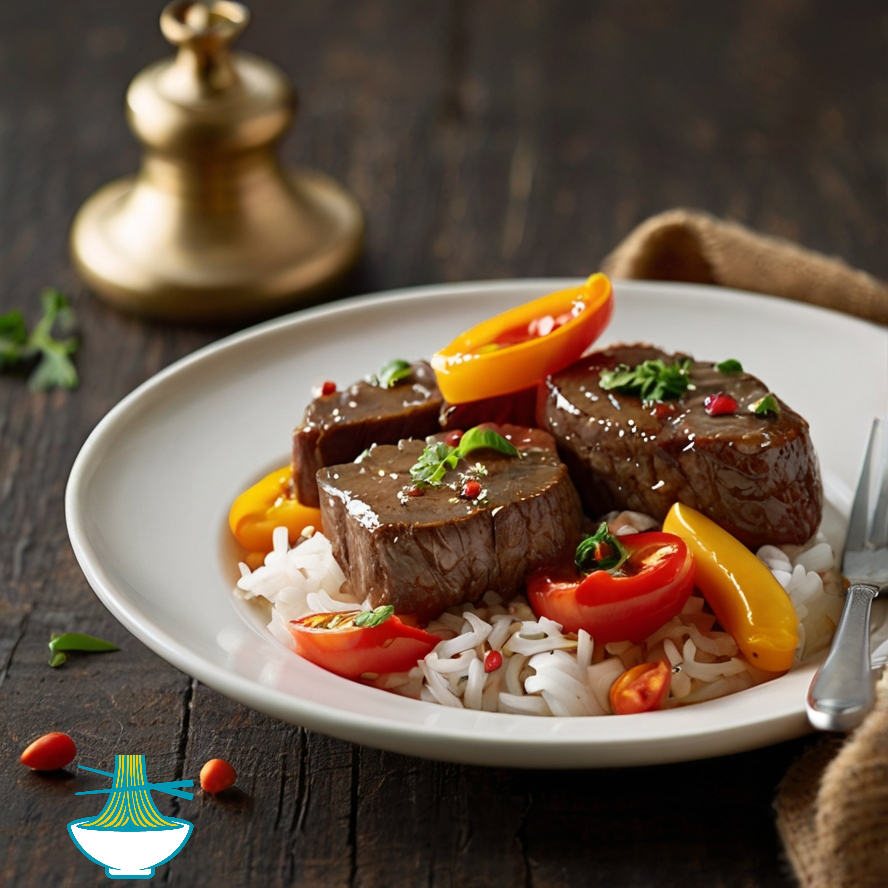Beef liver with bell pepper and onion is a flavorful, nutrient-dense dish that delivers exceptional health benefits. Rich in iron, it supports red blood cell production, combats fatigue, and enhances energy levels. The liver is also a powerhouse of B vitamins, essential for brain health and energy metabolism. Complementing the liver, the vibrant bell peppers are loaded with vitamin C and antioxidants, boosting the immune system and promoting overall well-being. This quick and easy recipe combines taste with nutrition, making it an ideal choice for anyone looking to incorporate wholesome, nutrient-rich foods into their diet.

Ingredients
- 300g beef liver, sliced
- 1 red bell pepper, sliced
- 1 yellow bell pepper, sliced
- 1 onion, sliced
- 3 garlic cloves, minced
- 2 tbsp buffalo ghee (or any cooking oil)
- Salt, to taste
- Black pepper, to taste
- Cumin, to taste
Instructions
1. Sauté Aromatics: In a large skillet, heat the buffalo ghee over medium heat. Add the sliced onions and minced garlic. Sauté until the onions are translucent and fragrant, about 3-4 minutes.
2. Cook the Liver: Add the sliced beef liver to the skillet. Cook for 3-4 minutes on each side, until browned and just cooked through.
3. Add Vegetables: Toss in the sliced bell peppers. Season with salt, black pepper, and cumin. Continue to cook for another 5 minutes, allowing the peppers to soften while the liver finishes cooking.
4. Serve: Remove from heat and serve hot. Enjoy with rice, quinoa, or on its own for a low-carb option.
Additional tips
- To enhance the flavor, marinate the liver in garlic, lemon juice, and olive oil for 20 minutes before cooking.
- Add a touch of paprika for a smoky flavor that complements the richness of the liver.
Serving Suggestions:
- Pair this dish with a fresh green salad or roasted vegetables for a complete meal.
- Serve with whole-grain bread or flatbread to balance the flavors and add fiber.
Frequently Asked Questions
Can this dish be stored?
- Yes, it can be stored in an airtight container in the refrigerator for up to 3 days. Reheat gently on low heat to avoid overcooking the liver.
Is this recipe suitable for children?
- Yes, but the flavors might be intense for some children. You can adjust by reducing the cumin and black pepper and ensuring the liver is well-cooked but tender.
What is the ideal cooking time for liver?
- Liver should be cooked for 3-4 minutes per side on medium heat. Overcooking can make it tough and less palatable.
Can this recipe be adapted for vegetarians?
- While liver cannot be substituted in a vegetarian diet, you can create a similar dish using mushrooms for their earthy flavor, complemented with the same spices and bell peppers.
How can I reduce the strong taste of liver?
- Soak the liver in milk for 30 minutes before cooking. This helps remove any metallic taste and makes the liver more tender.
What are the best bell peppers for this recipe?
- Red and yellow bell peppers are ideal as they are sweeter and balance the richness of the liver.
What are the general health benefits of eating liver?
- Liver is a nutrient powerhouse, providing essential vitamins such as A, B12, and folate, which support vision, energy metabolism, and red blood cell production.
What precautions should be taken when consuming liver?
- Avoid eating liver more than once a week to prevent vitamin A overload.
Consult a doctor if you have pre-existing health conditions, such as high cholesterol or liver disease.
How can the recipe be adjusted for people with allergies?
- Substitute cumin with milder spices if someone is sensitive to its flavor. Opt for alternative fats like olive oil to cater to those allergic to animal-based ghee.
Is this recipe low-carb?
- Yes, this dish is naturally low in carbohydrates and can be enjoyed by individuals following low-carb or ketogenic diets.

Nutrition Value:
1. 300g beef liver, sliced
- Calories: approximately 330
- Carbohydrates: 0g
- Protein: 66g
- Fat: 10g
- Sodium: 90mg
- Cholesterol: 330mg
- Vitamins: high in vitamin A, B12, riboflavin, niacin, and folate
- Minerals: rich in iron, phosphorus, and zinc
- Nutritional benefit: excellent source of iron, preventing anemia, and provides essential B vitamins for energy metabolism.
2. 1 red bell pepper, sliced
- Calories: approximately 25
- Carbohydrates: 6g
- Protein: 1g
- Fat: 0g
- Sodium: 1mg
- Cholesterol: 0mg
- Vitamins: high in vitamin C, vitamin A, and vitamin B6
- Minerals: contains potassium and folate
- Nutritional benefit: rich in antioxidants, particularly vitamin C, supporting the immune system.
3. 1 yellow bell pepper, sliced
- Calories: approximately 25
- Carbohydrates: 6g
- Protein: 1g
- Fat: 0g
- Sodium: 1mg
- Cholesterol: 0mg
- Vitamins: high in vitamin C, vitamin A, and vitamin B6
- Minerals: contains potassium and folate
- Nutritional benefit: great source of vitamin C and antioxidants, reducing inflammation.
4. 1 onion, sliced
- Calories: approximately 44
- Carbohydrates: 10g
- Protein: 1g
- Fat: 0g
- Sodium: 4mg
- Cholesterol: 0mg
- Vitamins: contains vitamin C, vitamin B6, and folate
- Minerals: contains potassium and manganese
- Nutritional benefit: provides flavonoids with anti-inflammatory properties promoting heart health.
5. 3 garlic cloves, minced
- Calories: approximately 13
- Carbohydrates: 3g
- Protein: 0.6g
- Fat: 0g
- Sodium: 1mg
- Cholesterol: 0mg
- Vitamins: contains vitamin C, vitamin B6, and manganese
- Minerals: contains selenium and calcium
- Nutritional benefit: has antimicrobial properties, lowering blood pressure and cholesterol levels.
6. 2 tbsp buffalo ghee (or any cooking oil)
- Calories: approximately 240
- Carbohydrates: 0g
- Protein: 0g
- Fat: 28g
- Sodium: varies depending on the brand
- Cholesterol: 40mg
- Vitamins: contains vitamin A and E
- Minerals: contains butyrate, a beneficial fatty acid
- Nutritional benefit: source of healthy fats supporting brain health and digestion.
7. Salt, to taste
- Calories: 0
- Carbohydrates: 0g
- Protein: 0g
- Fat: 0g
- Sodium: varies based on amount used
- Cholesterol: 0mg
- Vitamins: 0
- Minerals: contains sodium
- Nutritional benefit: essential for maintaining fluid balance and nerve function, should be consumed in moderation.
8. Black pepper, to taste
- Calories: negligible
- Carbohydrates: negligible
- Protein: negligible
- Fat: negligible
- Sodium: negligible
- Cholesterol: 0mg
- Vitamins: contains vitamin K
- Minerals: contains manganese and iron
- Nutritional benefit: contains piperine, enhancing nutrient absorption and has antioxidant properties.
9. Cumin, to taste
- Calories: approximately 8 (for 1 tsp)
- Carbohydrates: 1g
- Protein: 0.4g
- Fat: 0.4g
- Sodium: negligible
- Cholesterol: 0mg
- Vitamins: contains vitamin E and B vitamins
- Minerals: rich in iron, magnesium, and manganese
- Nutritional benefit: has anti-inflammatory properties, may aid digestion and boost the immune system.


Comments